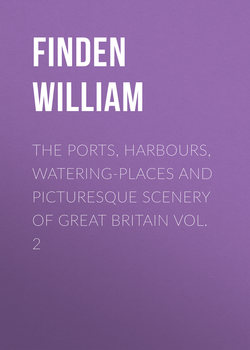Читать книгу The Ports, Harbours, Watering-places and Picturesque Scenery of Great Britain Vol. 2 - Finden William - Страница 5
NEW BRIGHTON
ОглавлениеNew Brighton has already taken a prominent station in the list of fashionable watering-places, and in several respects bids fair to eclipse even the attractions of its celebrated namesake in Sussex. Highly favoured by nature in a romantic point of view, the striking features of this locality have been duly taken advantage of in constructing a series of marine villas, all in harmony with the native landscape. These, with the most picturesque effects as viewed from a distance, combine every accommodation that can be desired, – either for families of distinction, or private individuals; while the air, which the invalid inhales from the atmosphere around him, produces a degree of vigour and exhilaration, which is rarely experienced in situations more inland or less elevated.
"The rural wilds
Invite; the mountains call you; and the vales,
The woods, the streams, and each ambrosial breeze
That fans the ever-undulating sky —
A kindly sky!"
The honour of founding New Brighton belongs to James Atherton, Esq. A bold design, as it at first appeared, but which judgment, taste, and a liberal hand have converted into a lasting monument, – creditable alike to the originator and to the discriminating public, who have manifested a decided preference for the situation, and thus amply justified the enterprise. The first step taken by Mr. Atherton was to purchase nearly two hundred acres of land, including the site of the future town. These were put under the care of persons well instructed in the plan of operations. The design was prosecuted with unremitting zeal; houses sprang up, streets were laid out, and in a comparatively short time the skeleton of New Brighton was completed. Strangers resorted to the spot; the citizens of Liverpool became eager for its completion, and for those enjoyments which it presented as a summer retreat, as well as for the many advantages which it offered to the invalid. Thus encouraged by the vote of public approbation, the works made rapid progress, and shortly after assumed the name and consideration of a favourite watering-place.
In the design and execution of the various embellishments of the place, the architect has never stepped aside from the rules of good taste. The pleasure and accommodation of the visitors have been carefully studied. Spacious streets, fifteen yards in breadth and nearly a mile in length, insure a free circulation of air, and throw open an agreeable promenade to the public, who resort thither in great numbers during the summer and autumn. The partiality evinced for this watering place, (of which the inhabitants can so readily take advantage,) is every day adding to the number of its visitors, and thereby contributing to the further extension of the original plan. A commodious and elegant hotel has been erected, where casual visitors and others, in conjunction with the allurements of a well-served table, can enjoy the exhilarating prospect of the sea, and the numberless vessels of all denominations that stud and traverse its waters. For the accommodation of the resident population, a reservoir, containing nearly two thousand gallons of water, has been constructed, and supplied from a fine spring on the beach.
The Fort and Lighthouse are objects well deserving of attention. The former is very strongly built, and covers a space of nearly four thousand yards. It is approached from the main land by means of a drawbridge, and mounts sixteen pieces of cannon with others in the embrasures of the towers. On account of the great sandbank at the entrance of the river, it is ordered that every ship of heavy burden shall pass within nine hundred yards of the Fort.
The Lighthouse is constructed of Anglesey marble, and is considered a masterpiece of its kind. It rises about ninety feet above the rock; each stone is worked to a given geometrical form, and made to lock and dovetail with those adjoining with great accuracy. The whole is cemented together by a liquid volcanic substance brought from the vicinity of Mount Ætna, which, in the course of time, becomes as hard as marble. The lantern is illuminated by revolving lights – two of which are brilliantly white, and the other of a deep red. The work is from the design of Mr. Foster, and executed by Mr. Tomkinson, at an expense to the Liverpool Corporation of twenty-seven thousand five hundred pounds.
